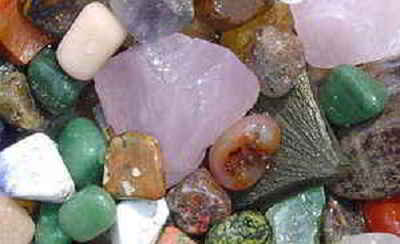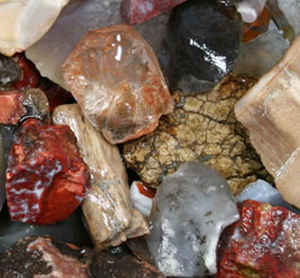
Arkansas Symbols
Arkansas State Rock
Bauxite

Adopted on February 22, 1967.
Bauxite was adopted as the Arkansas State Rock by the General Assembly of 1967. Senate Bill No. 143 was passed in both houses of the Arkansas State Legislature and signed into law by Governor Winthrop Rockefeller on February 22, 1967.
Bauxite is used to make aluminum, which is used to make cans, aluminum foil, and many other useful products. Arkansas is home to the largest bauxite deposits in the United States, located in Saline County.
Arkansas State Rock: Bauxite

Bauxite, an aluminium ore, is the world's main source of aluminium. It consists mostly of the minerals gibbsite Al(OH)3, boehmite γ-AlO(OH) and diaspore α-AlO(OH), mixed with the two iron oxides goethite and haematite, the clay mineral kaolinite and small amounts of anatase TiO2. Bauxite was named by the French geologist Pierre Berthier in 1821 after the village of Les Baux in Provence, southern France, where he discovered it and was the first to recognize that it contained aluminium.
As a convenient and common source of alumina, bauxite ore was first commercially mined in Jamaica in 1854. Almost 35 years later, Karl Joseph Bayer described the process (now known as the Bayer Process) that dramatically reduced the cost of aluminum metal production and moved it from the realm of precious metals into that of everyday commodity.
Bauxite was first identified in Arkansas by then-State Geologist John C. Branner in 1887. The Arkansas Bauxite region, home to the largest Bauxite deposits in the United States, covers about 275 square miles near the center of the state in Pulaski and Saline Counties.
At one time Arkansas produced 97% of the nation's bauxite. In 1887 the state's first geologist discovered huge deposits of bauxite in Saline and Pulaski Counties. Bauxite quickly became an extremely profitable venture. In 1903 the Pittsburgh Reduction Company of Pennsylvania (later known as Alcoa) established a company town and named it Bauxite. During the 64 years the company was in business, all inhabitants of the town were employees. The Gann Museum of Benton is the only building in the world made out of bauxite. Bauxite is no longer produced and the mined land is now being reclaimed.
Bauxite forms most commonly in deeply weathered rocks as a hydrated aluminum oxide ore. In some locations, the parent material is basalt or other volcanic rocks.
Bauxite developed during the early Tertiary time period, starting first as soils then going through a process known as tropical weathering into the igneous rock bauxite. Shallow seas and shorelines covered the West Gulf Coastal Plain during this time period. Aluminum, which is extracted from bauxite is the third most abundant element found in the earth's crust. Its light weight and strength make it a very versatile metal. The main use of Arkansas bauxite was in the manufacture of metallic aluminum. Uses today include the manufacture of artificial abrasives, chemicals, refractories, cements, absorbents (including kitty litter), and catalysts. Aluminum paint, beverage cans, baseball bats, high-voltage power lines, house siding, boats, and airplanes are just some of the many products made from aluminum.
Arkansas Law
The law designating the Bauxite as the official Arkansas state rock is found in the Arkansas Code, Title 1, Chapter 4, Section 1-4-111 - State gem, mineral, and rock.
Title 1 - General Provisions
Chapter 4 - State Symbols, Motto, Etc.
§ 1-4-111 - State gem, mineral, and rock.
Universal Citation: AR Code § 1-4-111 (2012)
(a) The diamond is adopted and designated the official state gem of the State of Arkansas.
(b) Quartz crystal is adopted and designated the official state mineral of the State of Arkansas.
(c) Bauxite is adopted and designated the official state rock of the State of Arkansas.
History. Acts 1967, No. 128, § 1-3; A.S.A. 1947, § 5-115 - 5-117.
Minerals, & Gems

Gemstone, Minerals, Rocks






